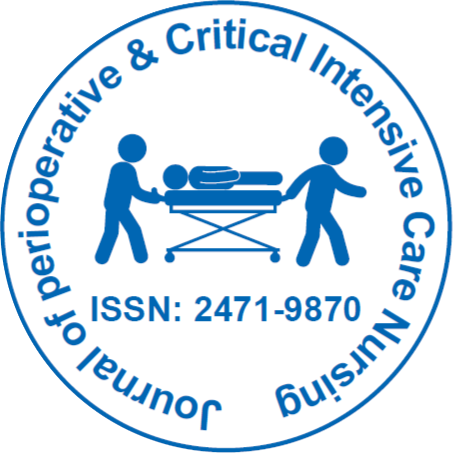
Journal of Perioperative & Critical Intensive Care Nursing
Open Access
ISSN: 2471-9870
+44-77-2385-9429

ISSN: 2471-9870
+44-77-2385-9429
Perspective - (2024)Volume 10, Issue 3
Wound care is a fundamental component of healthcare that significantly influences patient recovery and quality of life. Effective management of wounds, whether they arise from surgical procedures, trauma, or chronic conditions, is important for preventing complications and promoting healing. This article delves into the principles, techniques and innovations in wound care, highlighting its importance across various healthcare settings.
Understanding the types of wounds is essential for effective care. Acute and chronic wounds are two different categories. Acute wounds, such as cuts and surgical incisions, typically heal within a predictable timeframe. In contrast, chronic wounds, including diabetic ulcers and pressure injuries, persist for longer periods and often require specialized interventions. Recognizing the nature and stage of a wound is vital for determining the appropriate treatment strategy.
Principles of wound care
Effective wound care is guided by several fundamental principles:
Assessment: Determining the wound's size, depth and quality requires a comprehensive examination. This evaluation also includes assessing the surrounding tissue, signs of infection and the patient's overall health status.
Cleaning: Proper cleaning of the wound helps remove debris, bacteria, and dead tissue. Saline solutions or mild antiseptics are commonly used to cleanse wounds without causing further irritation.
Protection: Protecting the wound from external contaminants and friction is vital. Appropriate dressings serve this purpose, providing a barrier against bacteria while allowing for gas exchange.
Monitoring: Regular monitoring of the wound is essential to assess healing progress and identify any complications early. This includes checking for signs of infection, changes in size, or alterations in the surrounding tissue.
Techniques in wound care
Debridement: Debridement is a vital wound care treatment that entails clearing the wound site of debris, foreign objects, and necrotic tissue. Debridement can be accomplished in a number of ways, such as mechanical, enzymatic, autolytic, or surgical. Effective debridement promotes healing by creating a clean wound bed and facilitating the growth of new tissue.
Dressing selection: Choosing the appropriate dressing is key to successful wound management. Various dressings are available, each designed for specific types of wounds. For instance, hydrocolloid dressings are ideal for moderate exudate, while alginate dressings are suited for heavily exuding wounds. The right dressing not only supports healing but also minimizes pain and discomfort for the patient.
Infection control: Preventing infection is a paramount concern in wound care. This involves not only proper cleaning and dressing techniques but also educating patients on signs of infection. Healthcare providers should encourage patients to report any unusual changes, such as increased redness, swelling, or drainage. In cases of infection, prompt treatment with antibiotics or other interventions is essential.
Innovations in wound care
Recent advancements in wound care have introduced innovative technologies and materials that enhance traditional practices. Bioengineered skin substitutes and Negative Pressure Wound Therapy (NPWT) represent significant breakthroughs in the field. Bioengineered products provide a scaffold for tissue regeneration, while NPWT utilizes vacuum pressure to improve blood flow and remove excess fluid from the wound site. These innovations have improved outcomes for patients with complex wounds. Additionally, the integration of telemedicine has become increasingly important, allowing healthcare providers to monitor wounds remotely. This approach is particularly beneficial for patients with chronic wounds, providing continuous support and reducing the need for frequent in-person visits.
In conclusion, effective wound care is essential for promoting healing and enhancing patient well-being. By adhering to established principles, employing appropriate techniques and embracing innovations in the field, healthcare providers can optimize wound management and improve overall health outcomes. As the landscape of wound care continues to evolve, ongoing education and awareness of best practices will remain critical. Through dedicated attention to wound management, healthcare professionals can significantly impact the recovery drive of their patients, fostering a complete approach to healing. Ultimately, a comprehensive approach to wound care not only addresses the physical aspects of healing but also supports the emotional and psychological well-being of patients, paving the way for a smoother recovery process.
Citation: Roldine D (2024). Role of Advanced Dressings and Therapies in Wound Management: Impact on Modern Wound Care . J Perioper Crit Intensive Care Nurs.10:259.
Received: 29-Aug-2024, Manuscript No. JPCIC-24-34553 ; Editor assigned: 02-Sep-2024, Pre QC No. JPCIC-24-34553 (PQ); Reviewed: 16-Sep-2024, QC No. JPCIC-24-34553; Revised: 23-Sep-2024, Manuscript No. JPCIC-24-34553 (R); Published: 30-Sep-2024 , DOI: 10.35248/2471-9870.24.10.259
Copyright: © 2024 Roldine D. This is an open-access article distributed under the terms of the Creative Commons Attribution License, which permits unrestricted use, distribution and reproduction in any medium, provided the original author and source are credited